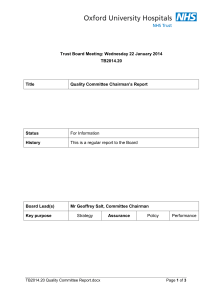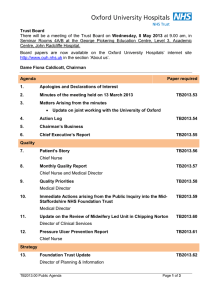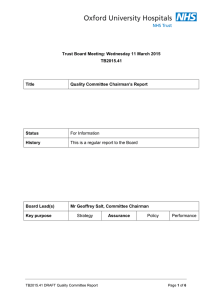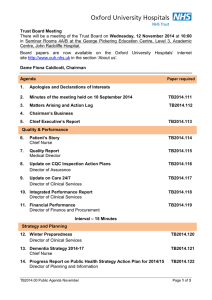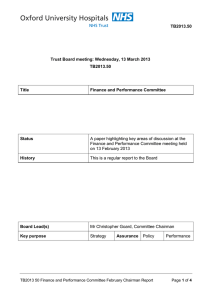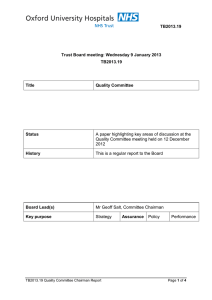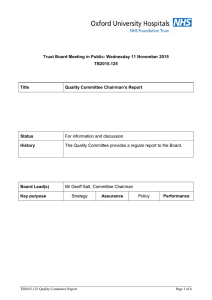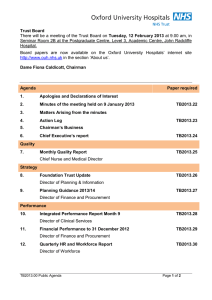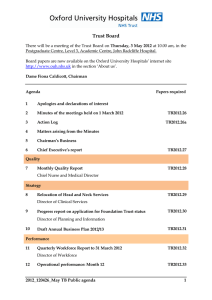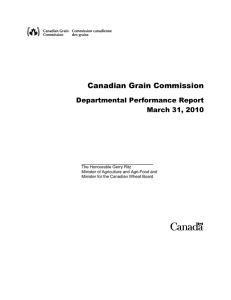Trust Board Meeting: Wednesday 14 January 2015 TB2015.20 Title
advertisement
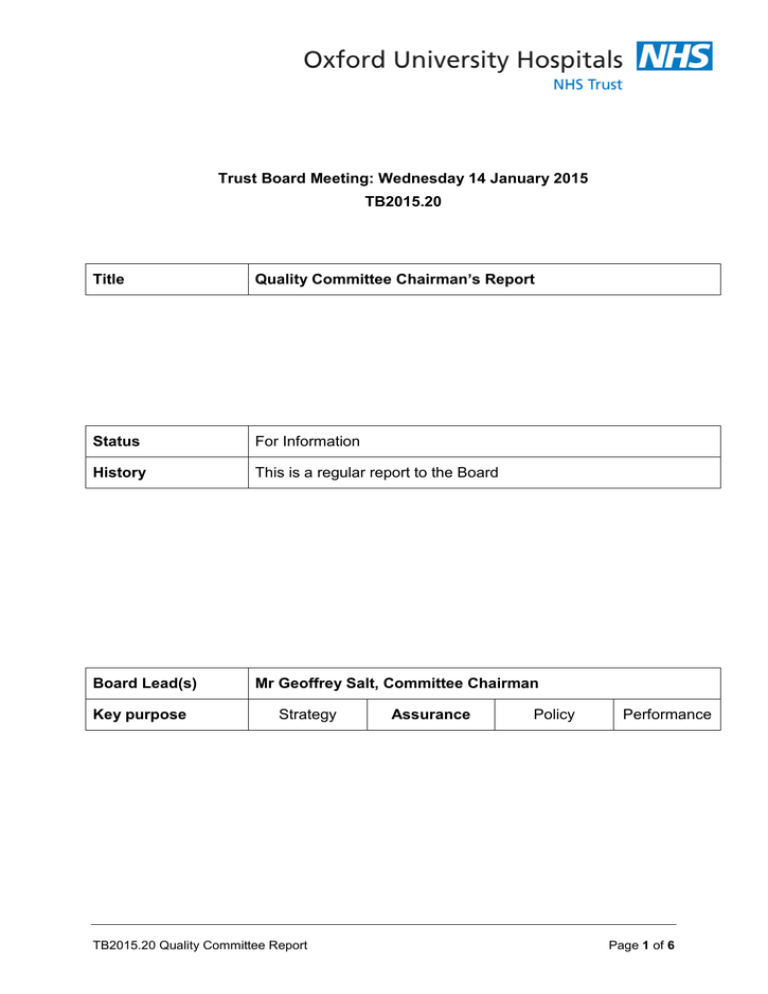
Trust Board Meeting: Wednesday 14 January 2015 TB2015.20 Title Quality Committee Chairman’s Report Status For Information History This is a regular report to the Board Board Lead(s) Mr Geoffrey Salt, Committee Chairman Key purpose Strategy TB2015.20 Quality Committee Report Assurance Policy Performance Page 1 of 6 Oxford University Hospitals TB2015.20 1. Introduction The Quality Committee met on 10 December 2014. The main issues raised and discussed at the meeting are set out below. 2. Significant issues of interest to the Board The following issues of interest have been highlighted for the Trust Board: • The Committee received a patient story which highlighted key issues for organisational learning in relation to the importance of paying all due respect and attention to a patient’s privacy and dignity in a busy clinical environment, including specifically not conversing with a colleague in a foreign language when in the patient’s presence, nor otherwise excluding the patient by speaking about her to a relative in the third person. The importance of trying to ensure that the selection of Patient Stories was representative of patients’ experience, and reflective of the key themes that tended to recur in patients’ complaints, was stressed. Whilst many complainants might not be willing to co-operate in the co-production of a Patient Story, cross-reference should be made to current complaints themes when applying the selection criteria for Patient Stories. • An update was provided on progress and the next steps in implementation of the Patient Experience Strategy. • The Committee heard of emerging issues and concerns which were under investigation, the outcome of which would be reported as appropriate. • The Committee received the Quality Report, providing information on performance against a suite of fifty three quality metrics. Performance was highlighted in particular in relation to: • Dementia – RAG rated as ‘Red’, with 67.2% of patients aged >75 admitted as an emergency having been screened. It was noted that this had improved (up from 63.9% when reported to the Committee in October 2014), but further improvement was required, and it was proposed that better compliance could be achieved through a mandatory step being built into the Electronic Patient Record [EPR]. • VTE Risk Assessment – RAG rated as ‘Red’, with 94.73% of admitted patients receiving risk assessment. Again, it was noted that this had improved (up from 94.22% when reported to the Committee in October 2014); only just falling short of being RAG rated as ‘Amber’ (at 95%) and ‘Green’ (at 95.25%). • The Committee received the monthly safe staffing report, which was now included in the Quality Report as part of the regular reporting, showing fill TB2015.20 Quality Committee Report Page 2 of 6 Oxford University Hospitals TB2015.20 rates for October 2014 of 94.3% for Registered Nurses/Midwives and 94.8% for Care Support Workers (unregistered). • Proposals to refresh the Quality Strategy were presented, aimed at more clearly defining the Trust’s quality goals under the three main quality domains of patient experience, patient safety and effectiveness and outcomes. • The Committee supported a revised framework for escalating issues relating to quality performance, in line with that developed by NHS England. This was aimed at providing formal and informal reporting mechanisms, and raising awareness of the need for immediacy of report, related to the severity of the incident. More explicit provision would be made to cover the escalation of issues relating to quality performance from the Executive to the Board, and it would be important to measure not just the process, but also to demonstrate the substantive content of issues communicated. • On hearing that three incidents had been reported in November 2014 that met NHS England’s Never Event Criteria, the Committee sought further detail on the circumstances surrounding each incident, and the action taken to address the issues which had been raised. The three events which were discussed in detail related to: Misplaced naso gastric tube Wrong site surgery Retained guide wire In addition to initiating investigations of these events, all clinical divisions had been requested to provide assurance of their knowledge of the locations where activities were taking place that might lead to Never Events; and that staff in those locations were aware of the Never Events framework, of the Trust policies designed to prevent such events, and of the reporting arrangements in the event of incidents. • The Committee approved proposals for analysing the impact of delays on the quality of care, and in particular agreed that this should focus initially on o patients admitted to hospital for whom the Trust has failed to deliver the four hour ED standard; and on o patients waiting longer than planned for emergency surgery. • The Committee supported the formal response sent to the National Hip Fracture Database Annual Report 2014, citing evidence of solid contemporary governance processes in the service, namely that a broad range of key performance indicators were monitored monthly, and the mortality review process was robust. The Committee endorsed the conclusion that the hip fracture service at the Horton was currently safe, with no immediate alteration to the service model necessary. • An update was provided on progress against the Action Plan to reduce Avoidable Hospital Acquired Pressure Ulcers [AHAPU] 2014-16. The activities of the Trust’s Tissue Viability team were welcomed as having achieved a demonstrable, positive impact on education, and specialist knowledge TB2015.20 Quality Committee Report Page 3 of 6 Oxford University Hospitals TB2015.20 resource. Further work was on-going towards collaborative approaches with clinical staff and external partners. Overall, tissue viability practices were much improved, leading to a reduction of harm to patients. • The Committee considered the findings of a review undertaken of the effectiveness of the Clinical Governance Committee [CGC] and its subcommittees, and accepted the recommendations: o That a new proposed structure be approved for the CGC and its subcommittees; o That revised Terms of Reference be developed for the CGC, including rationalisation of its membership, for referral back to the Trust Management Executive [TME] for approval in January 2015; o That revised Terms of Reference be developed for the new proposed / merged committees, and that these be submitted to the next meeting of CGC for approval; o That the Assurance team develop guidance to support the committee secretaries and ensure that administration was standardised across all committees in line with best practice. • The regular report was received from the CGC, highlighting specific issues discussed, including: o Reinforcement of the OUH Patient Identification Policy, and the introduction of a new procedural checklist, following investigation into an incident on the Newborn Care Unit o Update on the delivery of same sex accommodation o Commissioning of a review and benchmarking exercise in relation to resuscitation training o Exemption of Radiologists from Methotrexate training until 31 March 2015, in the expectation that all Radiologists would undertake the new High Risk Medicines module, available from April 2015 o Request that a formal evaluation of the newly constituted Clinical Effectiveness Committee be provided to CGC in June 2015. • The Committee considered the actions required to ensure compliance with the new Care Quality Commission [CQC] regulation: Duty of Candour. It was noted that there were five Trust policies that would need to be reviewed and amended in response to the regulation, and training implications for staff once this work was completed. There would be practical implications related to the need to design a process to document “candour discussions” and to notify them for assurance purposes. TB2015.20 Quality Committee Report Page 4 of 6 Oxford University Hospitals TB2015.20 3 Key Risks Discussed The following risks were discussed: • The Committee considered updated extracts of the Corporate Risk Register [CRR] relating to the risks assigned to it, noting the following risks highlighted: i. ii. iii. iv. v. vi. • The risk of inaccurate reporting and poor data quality due to failings in the Picture Archiving and Communication System [PACS]; The risk of failure to deliver the required levels of CIP; The risk of failure to effectively control pay and agency costs; The risk of failure to reduce delayed transfers of care; The risk of failure to deliver national A&E targets; The difficulty in recruiting and retaining high quality staff in certain areas. At the request of the Committee’s Chairman, the Committee’s Vice-Chairman reported his reflections on the extent to which the key risks assigned to the Committee had been addressed in the presentation and discussion of papers submitted. Of the key ‘RED’ rated risks assigned to it, the risk of failure to reduce delayed transfers of care, and the risk of failure to deliver National A&E targets, had been addressed, as had the lack of robust plans across the healthcare system. However, further consideration could be given to the risk of failure in PACS, and to the difficulty of recruiting and retaining high-quality staff in certain areas. More broadly, it was suggested that the Committee would benefit from receiving less volume of information, and more focussed analysis of the key issues. There were indications of a systemic failure to communicate policy, and to monitor adherence thereto, and this was a risk which should also be recognised and addressed. These reflections will be taken into account when planning the agenda for the next meeting of the Committee on 11 February 2015. 4 Key decisions taken The following key decisions were made: • Further narrative should be provided in relation to safe Nurse and Midwifery Staffing Levels, to clarify what mitigating actions were taken in response to escalation of a shift, and to confirm whether the shift then ran on at least the minimum safe staffing level • A fuller Executive Summary would be provided to the Quality Report including some interpretation of the information presented, to help the Committee determine the level of assurance provided • The agendas for future meetings should consider the key risks assigned to the Committee TB2015.20 Quality Committee Report Page 5 of 6 Oxford University Hospitals TB2015.20 5 Agreed Key Actions The Committee agreed the following actions: • It was agreed that outstanding actions from Quality Walk Rounds would be followed up, to achieve closure where possible • An enhanced approach to monitoring Cost Improvement Programmes [CIP] was agreed, to help to increase the level of assurance in relation to on-going monitoring 6 Future Business Areas upon which the Committee will be focusing in the next three months will include: • • • • • Response to NHS England Guidance on Care Contact Time Review of the Corporate Risk Register Update on implementation of next phase of the Peer Review Programme On-going monitoring of progress in delivery of Action Plans relating to CQC Inspection; Review of Serious Incidents Requiring Investigation [SIRIs]; 7 Recommendation The Trust Board is asked to note the contents of this paper. Mr Geoffrey Salt Quality Committee Chairman January 2015 TB2015.20 Quality Committee Report Page 6 of 6
